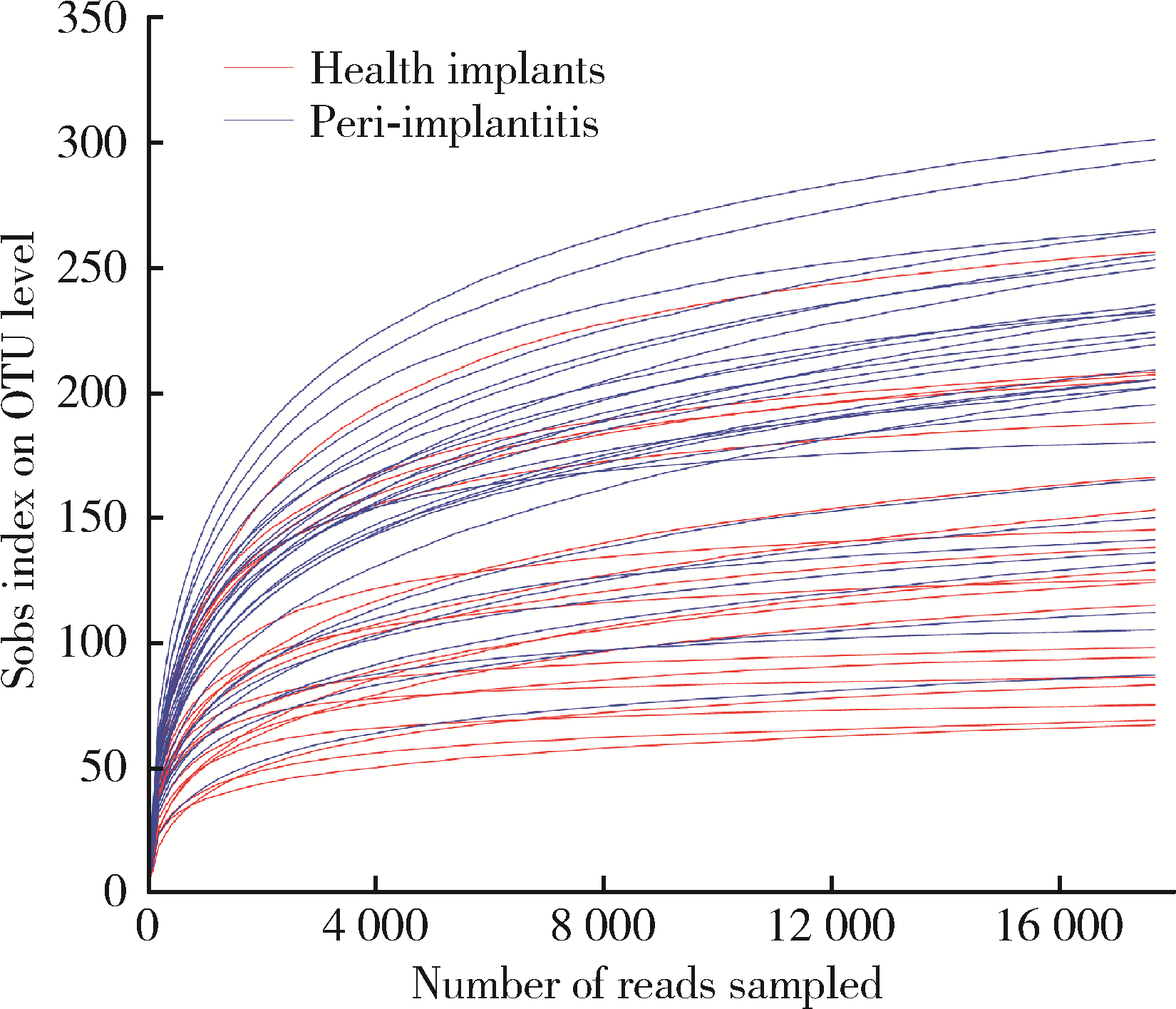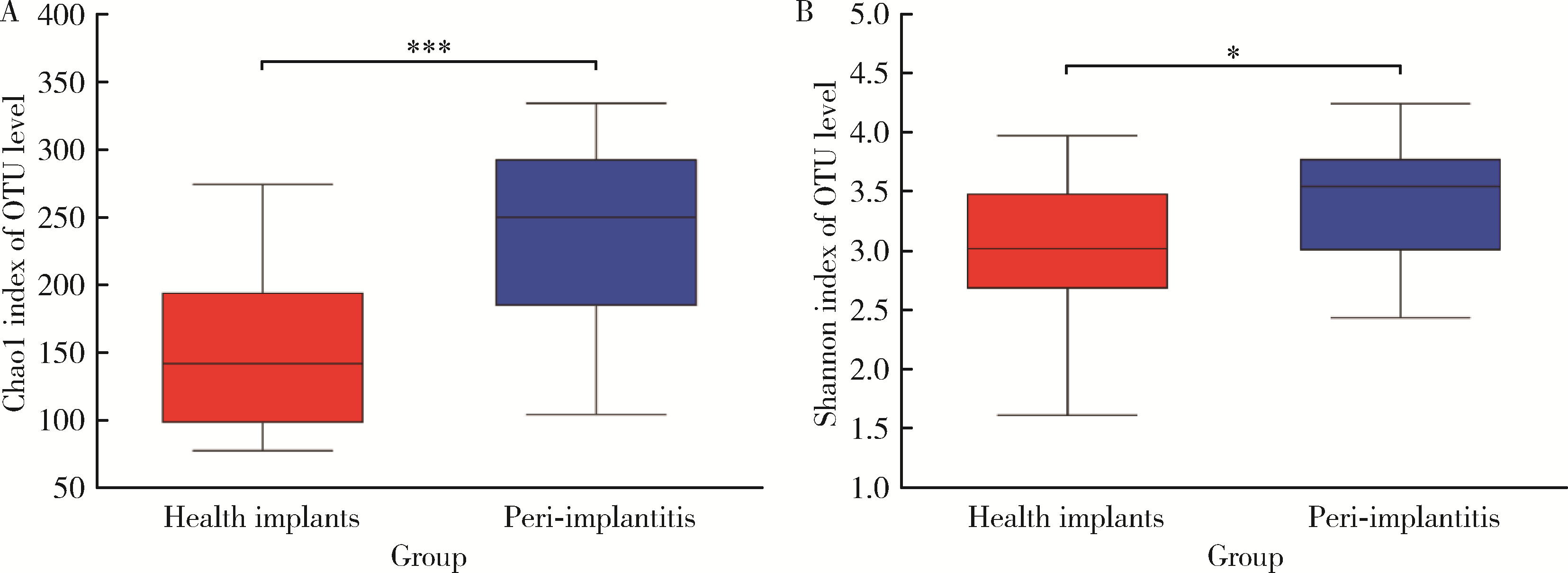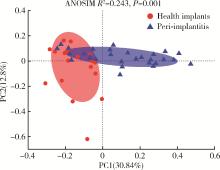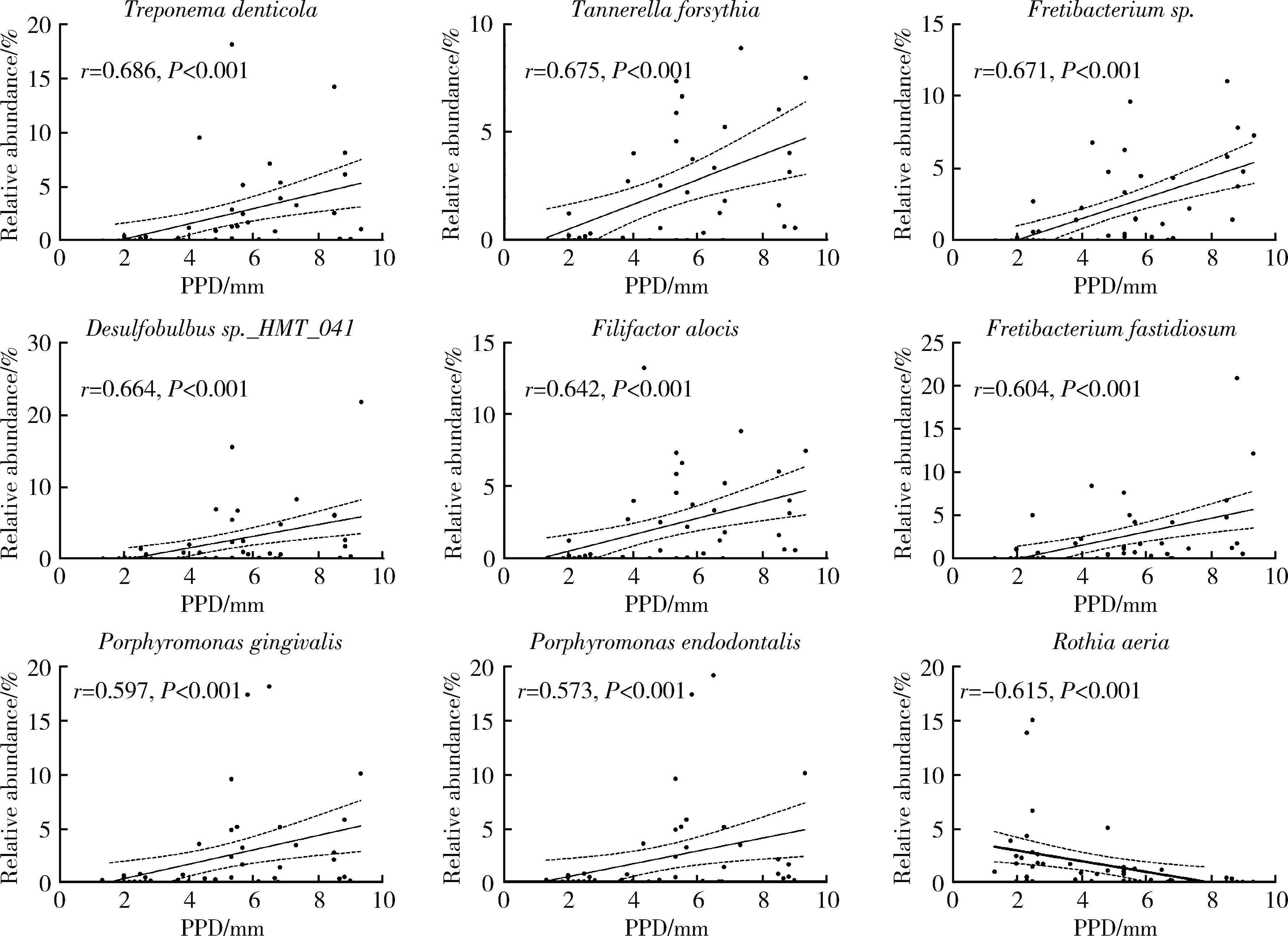Journal of Peking University (Health Sciences) ›› 2023, Vol. 55 ›› Issue (1): 30-37. doi: 10.19723/j.issn.1671-167X.2023.01.005
Previous Articles Next Articles
Profiles and differences of submucosal microbial in peri-implantitis and health implants: A cross-sectional study
Fei SUN,Jian LIU,Si-qi LI,Yi-ping WEI,Wen-jie HU*( ),Cui WANG*(
),Cui WANG*( )
)
- Department of Periodontology, Peking University School and Hospital of Stomatology & National Center of Stomatology & National Clinical Research Center for Oral Diseases & National Engineering Research Center of Oral Biomaterials and Digital Medical Devices, Beijing 100081, China
CLC Number:
- R781.4
| 1 |
Howe MS , Keys W , Richards D . Long-term (10-year) dental implant survival: A systematic review and sensitivity meta-analysis[J]. J Dent, 2019, 84, 9- 21.
doi: 10.1016/j.jdent.2019.03.008 |
| 2 | Schwarz F , Derks J , Monje A , et al. Peri-implantitis[J]. J Periodontol, 2018, 89 (Suppl 1): S267- S290. |
| 3 |
Kordbacheh Changi K , Finkelstein J , Papapanou PN . Peri-implan-titis prevalence, incidence rate, and risk factors: A study of electronic health records at a U.S. dental school[J]. Clin Oral Implants Res, 2019, 30 (4): 306- 314.
doi: 10.1111/clr.13416 |
| 4 | Berglundh T , Armitage G , Araujo MG , et al. Peri-implant diseases and conditions: Consensus report of workgroup 4 of the 2017 World Workshop on the Classification of Periodontal and Peri-Implant Diseases and Conditions[J]. J Clin Periodontol, 2018, 45 (Suppl 20): S286- S291. |
| 5 | Renvert S , Persson GR , Pirih FQ , et al. Peri-implant health, peri-implant mucositis, and peri-implantitis: Case definitions and diagnostic considerations[J]. J Periodontol, 2018, 89 (Suppl 1): S304- S312. |
| 6 | Araujo MG , Lindhe J . Peri-implant health[J]. J Clin Periodontol, 2018, 45 (Suppl 20): S230- S236. |
| 7 |
孙菲, 李思琪, 危伊萍, 等. 种植体周病非手术治疗中联合应用甘氨酸粉喷砂的临床效果评价[J]. 北京大学学报(医学版), 2022, 54 (1): 119- 125.
doi: 10.19723/j.issn.1671-167X.2022.01.019 |
| 8 |
de Waal YC , Eijsbouts HV , Winkel EG , et al. Microbial characteristics of peri-implantitis: A case-control study[J]. J Periodontol, 2017, 88 (2): 209- 217.
doi: 10.1902/jop.2016.160231 |
| 9 |
Paster BJ , Olsen I , Aas JA , et al. The breadth of bacterial diversity in the human periodontal pocket and other oral sites[J]. Periodontology 2000, 2006, 42 (1): 80- 87.
doi: 10.1111/j.1600-0757.2006.00174.x |
| 10 |
Renvert S , Roos-Jansaker AM , Lindahl C , et al. Infection at titanium implants with or without a clinical diagnosis of inflammation[J]. Clin Oral Implants Res, 2007, 18 (4): 509- 516.
doi: 10.1111/j.1600-0501.2007.01378.x |
| 11 |
Zheng H , Xu L , Wang Z , et al. Subgingival microbiome in patients with healthy and ailing dental implants[J]. Sci Rep, 2015, 5, 10948.
doi: 10.1038/srep10948 |
| 12 |
Sanz-Martin I , Doolittle-Hall J , Teles RP , et al. Exploring the microbiome of healthy and diseased peri-implant sites using Illumina sequencing[J]. J Clin Periodontol, 2017, 44 (12): 1274- 1284.
doi: 10.1111/jcpe.12788 |
| 13 |
Nie J , Zhang Q , Zheng H , et al. Pyrosequencing of the subgingival microbiome in peri-implantitis after non-surgical mechanical debridement therapy[J]. J Periodontal Res, 2020, 55 (2): 238- 246.
doi: 10.1111/jre.12708 |
| 14 |
Socransky SS , Haffajee AD , Cugini MA , et al. Microbial complexes in subgingival plaque[J]. J Clin Periodontol, 1998, 25 (2): 134- 144.
doi: 10.1111/j.1600-051X.1998.tb02419.x |
| 15 |
Al-Ahmad A , Muzafferiy F , Anderson AC , et al. Shift of micro-bial composition of peri-implantitis-associated oral biofilm as revealed by 16S rRNA gene cloning[J]. J Med Microbiol, 2018, 67 (3): 332- 340.
doi: 10.1099/jmm.0.000682 |
| 16 |
da Silva ES , Feres M , Figueiredo LC , et al. Microbiological diversity of peri-implantitis biofilm by Sanger sequencing[J]. Clin Oral Implants Res, 2014, 25 (10): 1192- 1199.
doi: 10.1111/clr.12231 |
| 17 |
Oliveira RR , Fermiano D , Feres M , et al. Levels of candidate periodontal pathogens in subgingival biofilm[J]. J Dent Res, 2016, 95 (6): 711- 718.
doi: 10.1177/0022034516634619 |
| 18 |
Fu JH , Wang HL . Breaking the wave of peri-implantitis[J]. Periodontol 2000, 2020, 84 (1): 145- 160.
doi: 10.1111/prd.12335 |
| 19 |
Perez-Chaparro PJ , Duarte PM , Shibli JA , et al. The current weight of evidence of the microbiologic profile associated with peri-implantitis: A systematic review[J]. J Periodontol, 2016, 87 (11): 1295- 1304.
doi: 10.1902/jop.2016.160184 |
| 20 |
Kroger A , Hulsmann C , Fickl S , et al. The severity of human peri-implantitis lesions correlates with the level of submucosal microbial dysbiosis[J]. J Clin Periodontol, 2018, 45 (12): 1498- 1509.
doi: 10.1111/jcpe.13023 |
| 21 |
Galofré M , Palao D , Vicario M , et al. Clinical and microbiological evaluation of the effect of Lactobacillus reuteri in the treatment of mucositis and peri-implantitis: A triple-blind randomized clinical trial[J]. J Periodontal Res, 2018, 53 (3): 378- 390.
doi: 10.1111/jre.12523 |
| 22 |
Mombelli A . Maintenance therapy for teeth and implants[J]. Periodontol 2000, 2019, 79 (1): 190- 199.
doi: 10.1111/prd.12255 |
| 23 |
Berglundh T , Jepsen S , Stadlinger B , et al. Peri-implantitis and its prevention[J]. Clin Oral Implants Res, 2019, 30 (2): 150- 155.
doi: 10.1111/clr.13401 |
| 24 |
Mombelli A . Microbial colonization of the periodontal pocket and its significance for periodontal therapy[J]. Periodontol 2000, 2018, 76 (1): 85- 96.
doi: 10.1111/prd.12147 |
| [1] | Congwei WANG,Min GAO,Yao YU,Wenbo ZHANG,Xin PENG. Clinical analysis of denture rehabilitation after mandibular fibula free-flap reconstruction [J]. Journal of Peking University (Health Sciences), 2024, 56(1): 66-73. |
| [2] | Qian DING,Wen-jin LI,Feng-bo SUN,Jing-hua GU,Yuan-hua LIN,Lei ZHANG. Effects of surface treatment on the phase and fracture strength of yttria- and magnesia-stabilized zirconia implants [J]. Journal of Peking University (Health Sciences), 2023, 55(4): 721-728. |
| [3] | Ling-wei MENG,Xue LI,Sheng-han GAO,Yue LI,Rui-tao CAO,Yi ZHANG,Shao-xia PAN. Comparison of three methods for establishing rat peri-implantitis model [J]. Journal of Peking University (Health Sciences), 2023, 55(1): 22-29. |
| [4] | LI Yi,YU Hua-jie,QIU Li-xin. Clinical classification and treatment decision of implant fracture [J]. Journal of Peking University (Health Sciences), 2022, 54(1): 126-133. |
| [5] | Fei SUN,Si-qi LI,Yi-ping WEI,Jin-sheng ZHONG,Cui WANG,Wen-jie HU. Efficacy of combined application of glycine powder air-polishing in non-surgical treatment of peri-implant diseases [J]. Journal of Peking University (Health Sciences), 2022, 54(1): 119-125. |
| [6] | LI Peng,PIAO Mu-zi,HU Hong-cheng,WANG Yong,ZHAO Yi-jiao,SHEN Xiao-jing. Radiography study on osteotome sinus floor elevation with placed implant simultaneously with no graft augmentation [J]. Journal of Peking University (Health Sciences), 2021, 53(1): 95-101. |
| [7] | Zhong ZHANG,Huan-xin MENG,Jie HAN,Li ZHANG,Dong SHI. Effect of vertical soft tissue thickness on clinical manifestation of peri-implant tissue in patients with periodontitis [J]. Journal of Peking University (Health Sciences), 2020, 52(2): 332-338. |
| [8] | Dong SHI,Jie CAO,Shi-ai DAI,Huan-xin MENG. Short-term outcome of regenerative surgery treating peri-implantitis [J]. Journal of Peking University(Health Sciences), 2020, 52(1): 58-63. |
| [9] | Chun-ping LIN,Song-he LU,Jun-xin ZHU,Hong-cheng HU,Zhao-guo YUE,Zhi-hui TANG. Influence of thread shapes of custom-made root-analogue implants on stress distribution of peri-implant bone: A three-dimensional finite element analysis [J]. Journal of Peking University(Health Sciences), 2019, 51(6): 1130-1137. |
| [10] | Qian WANG,Dan LI,Zhi-hui TANG. Sinus floor elevation and simultaneous dental implantation: A long term retrospective study of sinus bone gain [J]. Journal of Peking University(Health Sciences), 2019, 51(5): 925-930. |
| [11] | Xiao-qian LIU,Qiu-wen CHEN,Hai-lan FENG,Bing WANG,Jian QU,Zhen SUN,Mo-di HENG,Shao-xia PAN. Oral hygiene maintenance of locator attachments implant overdentures in edentulous population: A longitudinal study [J]. Journal of Peking University(Health Sciences), 2019, 51(1): 136-144. |
| [12] | Zhi-yong△ ZHANG,Tian MENG,Quan CHEN,Wen-shu LIU,Yu-huan CHEN. Retrospective analysis of early dental implant failure [J]. Journal of Peking University(Health Sciences), 2018, 50(6): 1088-1091. |
| [13] | ZHANG Hai-dong, ZHANG Li, SHI Dong, HAN Jie, YAN Xia, XIE Ye-si, MENG Huan-xin. Clinical study of locking-taper implants in patients treated for periodontitis [J]. Journal of Peking University(Health Sciences), 2018, 50(2): 300-307. |
| [14] | LIU Jing-yin, CHEN Fei, GE Yan-jun, WEI Ling, PAN Shao-xia, FENG Hai-lan. Influence of implants prepared by selective laser melting on early bone healing [J]. Journal of Peking University(Health Sciences), 2018, 50(1): 117-122. |
| [15] | LIANG Nai-wen, SHI Lei,HUANG Ying,DENG Xu-liang. Role of different scale structures of titanium implant in the biological behaviors of human umbilical vein endothelial cells [J]. Journal of Peking University(Health Sciences), 2017, 49(1): 43-048. |
|
||











